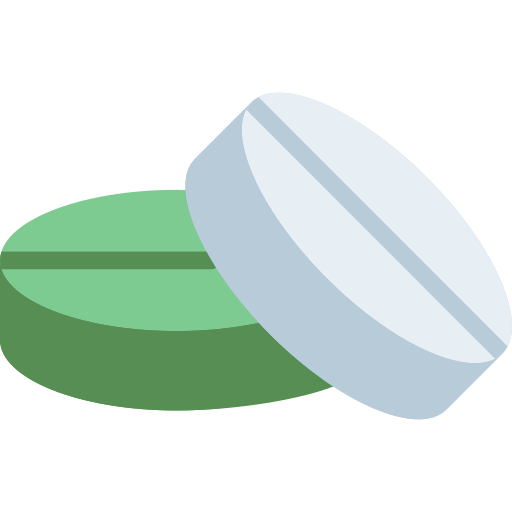
Irbesartan + Hydrochlorothiazide
150 mg+12.5 mg
UniMed UniHealth
Product Details
Description
Irbesartan & Hydrochlorothiazide tablet are indicated for the treatment of hypertension. This tablet may be used in patients whose blood pressure is not adequately controlled on monotherapy. This tablet may also be used as initial therapy in patients who are likely to need multiple drugs to achieve their blood pressure goals. The choice of Irbesartan & Hydrochlorothiazide tablets as initial therapy for hypertension should be based on an assessment of potential benefits and risks. Patients with stage 2 (moderate or severe) hypertension are at relatively high risk for cardiovascular events (such as strokes, heart attacks, and heart failure), kidney failure, and vision problems, so prompt treatment is clinically relevant. The decision to use a combination as initial therapy should be individualized and may be shaped by considerations such as the baseline blood pressure, the target goal, and the incremental likelihood of achieving goal with a combination compared with monotherapy.
Other antihypertensives, lithium, K-sparing diuretics, K supplements, salt substitutes containing K. CNS depressants, antidiabetics, cholestyramine & colestipol resins, corticosteroids, ACTH, digitalis glycosides, antiarrhythmics, NSAIDs, tubocurarine, antigout medications, Ca salts. Alcohol; diazoxide, atropine, beperiden, amantadine, cyclophosphamide, methotrexate.
Irbesartan: Hyperkalemia (19%), Chest pain (2%), Tachycardia (1%), Abnormal urination (2%), Musculoskeletal pain (6%), Flu-like syndrome (3%), Edema (3%), Tachycardia (1%), Chest pain (2%), Creatinine increased (1%), Increased BUN (2%), Dizziness (10%), URI (9%), Orthostatic hypotension (5%), Fatigue (4%), Diarrhea (3%), Dyspepsia (2%) Hydrochlorothiazide: Anorexia, Epigastric distress, Hypotension, Orthostatic hypotension, Photosensitivity, Anaphylaxis, Anemia, Confusion, Erythema multiforme, Stevens-Johnson syndrome, Exfoliative dermatitis including toxic epidermal necrolysis, Dizziness, Hypokalemia and/or hypomagnesemia, Hyperuricemia, Headache
Pregnancy Category D. Use of drugs that act on the renin-angiotensin system during the second and third trimesters of pregnancy reduces fetal renal function and increases fetal and neonatal morbidity and death. Resulting oligohydramnios can be associated with fetal lung hypoplasia and skeletal deformations. Potential neonatal adverse effects include skull hypoplasia, anuria, hypotension, renal failure, and death. When pregnancy is detected, discontinue Irbesartan and Hydrochlorothiazide as soon as possible. Thiazides cross the placenta, and use of thiazides during pregnancy is associated with a risk of fetal or neonatal jaundice, thrombocytopenia, and possibly other adverse reactions that have occurred in adults. Nursing Mothers: It is not known whether irbesartan is excreted in human milk, but irbesartan or some metabolite of irbesartan is secreted at low concentration in the milk of lactating rats. Thiazides appear in human milk. Because of the potential for adverse effects on the nursing infant, a decision should be made whether to discontinue nursing or discontinue the drug, taking into account the importance of the drug to the mother.
Child: Do not nurse Lactation: Discontinue drug or do not nurse
Renal Dose Adjustments: Mild to moderate renal dysfunction (CrCl 30 mL/min or greater): No adjustment recommended Severe renal dysfunction (CrCl less than 30 mL/min): Not recommended Liver Dose Adjustments: Caution recommended
Irbesartan: No data are available in regard to overdosage in humans. However, daily doses of 900 mg for 8 weeks were well tolerated. The most likely manifestations of overdosage are expected to be hypotension and tachycardia; bradycardia might also occur from overdose. Irbesartan is not removed by hemodialysis. To obtain up-to-date information about the treatment of overdosage, a good resource is a certified regional Poison Control Center. Telephone numbers of certified Poison Control Centers are listed in the Physicians’ Desk Reference (PDR). In managing overdose, consider the possibilities of multiple-drug interactions, drug-drug interactions, and unusual drug kinetics in the patient. Laboratory determinations of serum levels of irbesartan are not widely available, and such determinations have, in any event, no established role in the management of irbesartan overdose. Acute oral toxicity studies with irbesartan in mice and rats indicated acute lethal doses were in excess of 2000 mg/kg, about 25- and 50-fold the MRHD (300 mg) on a mg/m2 basis, respectively. Hydrochlorothiazide: The most common signs and symptoms of overdose observed in humans are those caused by electrolyte depletion (hypokalemia, hypochloremia, hyponatremia) and dehydration resulting from excessive diuresis. If digitalis has also been administered, hypokalemia may accentuate cardiac arrhythmias. The degree to which hydrochlorothiazide is removed by hemodialysis has not been established. The oral LD50 of hydrochlorothiazide is greater than 10 g/kg in both mice and rats.
Combined antihypertensive preparations
Should be stored in cool and dry place
-
Support 24/7
Call us anytime -
100% Safety
Only secure payments